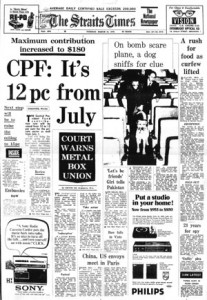Keeping up with the times – the changing look of Singapore’s longest surviving English newspaper The Straits Times.
— — — —
First published in The Design Society Journal,
and edited into seven posts for this site.
— — — —
A newspaper is often seen as a mirror of its society. While this usually refers to the content of the paper, what is often passed over is how its appearance is part of that reflection too.
If you stop reading the newspaper for a moment and examine its overall look and individual elements instead, you would notice how its nameplate, the type of underlying grid, choice of typefaces, and even the paper’s size come together to shape the experience of the newspaper that we take for granted in our daily read.
“Any newspaper we read conveys its personality through the accumulation of these visual cues,” writes visual communications professor Kevin G. Barnhurst.[i] “We assume that it is the writing that makes the difference, but that is only partly true.”
Yet newspaper design is more than its aesthetics, it is a means to convey a message, summed up in former editor of Britain’s The Sunday Times Harold Evans’ observation, “[D]esign is part of journalism. Design is not decoration. It is communication.”[ii]
It for this reason that newspapers, like The Straits Times (ST) in Singapore, have periodically spent money and time to redesign its product.
Explaining ST’s 1998 redesign, then editor Leslie Fong wrote: “The short answer is that we have to – if we wish to stay on top of the competition and give you a better paper.” He adds, “And the competition is not just against other media or information providers but also, increasingly, for your time.”[iii]
A newspaper’s design thus becomes a visual expression of its readers’ values and environment that the paper operates within. Each design change is a deliberate move driven by the need to stay relevant to its readers. In a sense the changing looks of the 164-year-old ST, the oldest English newspaper still around, serves as an archive of how Singapore has changed from a British colony to an independent First-World nation today.
— — — — — — — — — — — — — — — — — — — — — — — —
Introduction } 1960s } 1970s } 1980s } 1989 } 1998 } 2000s
— — — — — — — — — — — — — — — — — — — — — — — —
- [i] Kevin G. Barnhurst, Seeing the Newspaper, New York: St. Martin’s Press, 1994.
- [ii] Harold Evans, Book Five: Newspaper Design, 5 vols., Editing and Design: A Five-Volume Manual of English, Typography and Layout, London: Heinemann, 1973.
- [iii] Leslie Fong, “The Aim: To Give You a Better Paper ” The Straits Times, March 22 1998, HOME, 23.
— — — —

